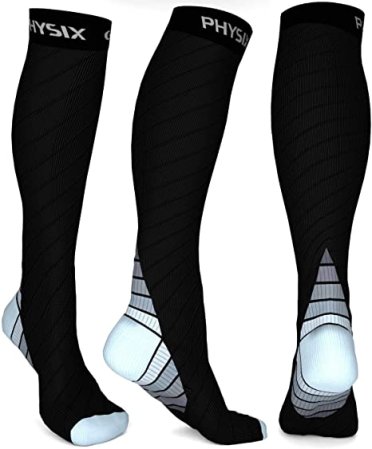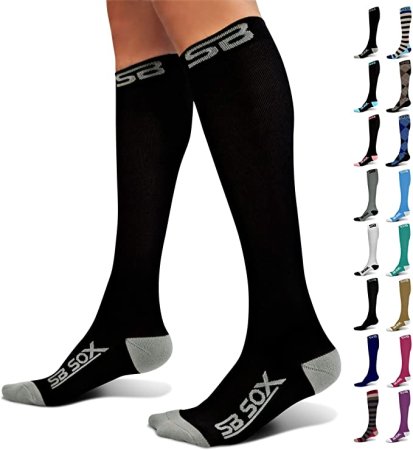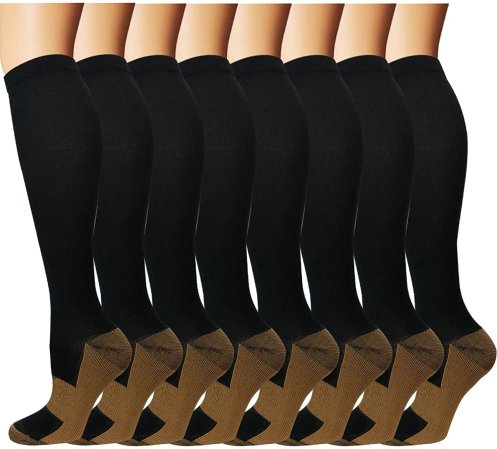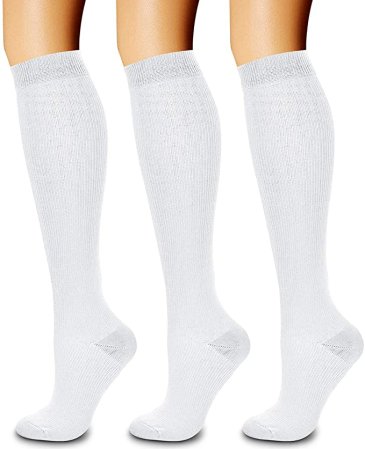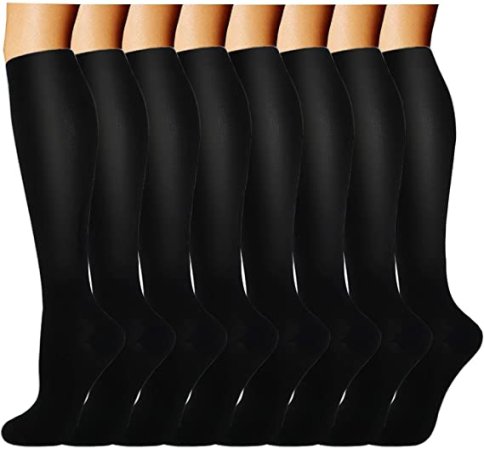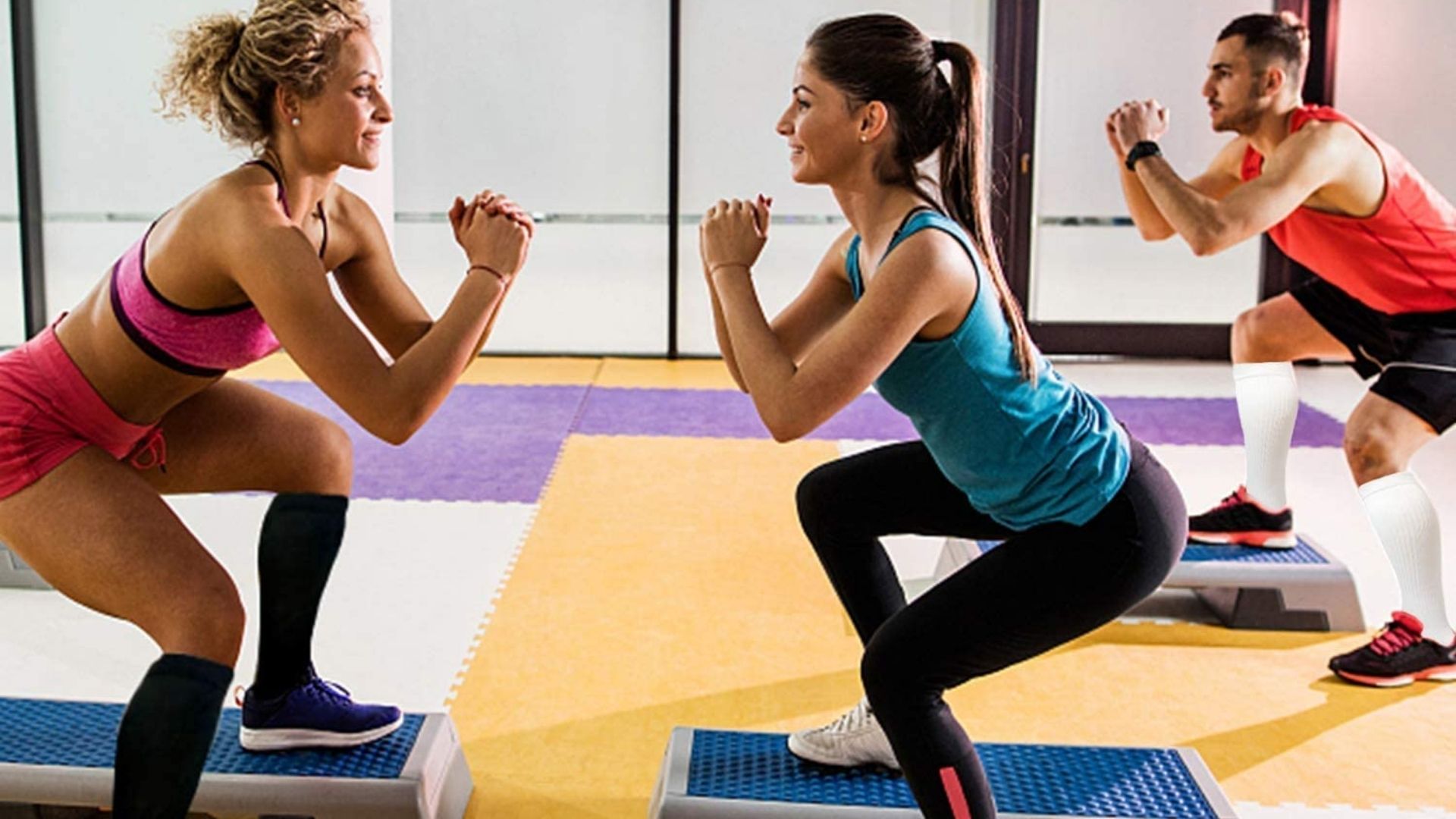

We may earn revenue from the products available on this page and participate in affiliate programs.
Spending time on your feet, no matter how good of shape you’re in, is hard on the system. Yes, you want to push yourself. Sure, you can do that extra set. But you can’t do it without support — the support of a good set of socks, that is. Built to assist with circulation by compressing the vascular system in your legs and feet, compression socks take the strain off of your system. It’s only natural to want to do it all, and you have a better chance by eliminating stress wherever you can.
Compression socks apply low-scale, even pressure to your legs and feet. As a result, you face fewer injury risks, are able to exercise for longer, and feel more comfortable. They might not be something you need all the time, but when you’re sore and still need to get going, compression socks can be a real lifesaver. Backed by science, the best compression socks can overhaul your whole workout routine. We’ve broken down everything you need to know to find the perfect fit to keep your legs comfortable and keep you happy.
Physix Gear Sport Compression Socks
SB Sox Compression Socks
Sooverki Graduated Medical Socks
Charmking Compression Socks
Actinput Compression Socks
Related: Stay warm and dry with these 6 high-quality hiking socks
Why should you trust us
With five years of experience writing product reviews, paired with three years as a news correspondent and an academic background in the sciences, I have curated a reputation for accuracy and dependability. Focusing primarily on tactical gear, automotive supplies, and the financial market, I offer reliable information on topics that matter to my readers. My work is featured on The Drive, Car Bibles, and Narcity Media. Some of my most recent pieces for Task and Purpose include reviews of fitness trackers, tactical backpacks, and hiking pants.
Types of compression socks
All compression socks need to provide even force on your calves and feet, though not all socks are made alike. Because of the vascular benefits of this gear, they are useful in tons of situations. Depending on how you plan to use them, whether it’s to relax and heal or kill it at your next workout, you’ll need a specific type of compression socks.
Graduated
This type of socks is designed to provide the most amount of compression at the ankle, making them well-suited for athletic uses. The pressure reduces as the sock rises up the calf, making it easier to move around since your blood can flow readily. However, since these socks have such specific amounts of compression needed in exact places, it can be hard to find the right fit without a podiatric consultation.
The socks in this category generally end just below the knee and are able to limit the accrual of fluid in your legs called edema. If you plan to use these for exercise, it’s worth seeking out extra features like moisture wicking and durability. Some models have reinforced heels and toes to limit wear and tear due to friction. These are ideal for runners and outdoor exercisers.
Non-medical
Some of the most popular amongst the modern population, these socks don’t require a prescription though offer the same level of comfort for those without a medical condition. Typically, these are made out of nylon or polyester blended with spandex. The former gives durability and ventilation while the spandex provides the squeezing effect for which the socks are known.
Unlike other types, these socks provide a consistent amount of compression throughout the socks. As a result, these are preferred for use when at rest. If you are healing from an injury or worried about the pressure changes on an airplane ride, this is the type of sock to get. Generally, it is pretty easy to find a fit with these socks so long as you take a measurement of your calf and consult the sizing chart from the manufacturer.
Medical
These socks are less common, largely due to the fact that they are usually recommended through a prescription as opposed to the consumer seeking them out. The socks are meant to offer a high level of compression throughout the material. This is to assist in the prevention of deep vein thrombosis, a painful medical condition.
Similar to graduated compression socks, the amount of force applied to the foot and legs is not consistent across the socks. Like graduated models, the pressure is greatest at the ankles and lessens as the socks get closer to the knee. The mmHg (millimetres of mercury, a blood pressure measurement that refers to systolic over diastolic readings) will be highest on this type of sock.
What to consider when buying compression socks
When assessing compression socks, the first thing to think about is how you plan to use them. Consider whether you will be at rest or in action while wearing the socks. Are you using these for health support purposes or for something more casual? The answer will dictate the type of sock you need. Hiking socks are much different than around-the-house socks, so be on the lookout for something that works for you. Athletes require more force at the ankle, while those looking for support and comfort can benefit from even pressure.
Armed with this information, you can then consider the material used. Do you have any fabric allergies or sensitivities? Think about whether the material in the socks wick away moisture or will they be soaking wet at the end of your workout.
Once you’ve sussed out the socks that meet your demands in terms of materials and function, look to the maintenance requirements. The last thing you want after a long day is to spend an hour washing your socks. Aim for options that are easy to take care of and won’t wear down due to friction. The goal is to get optimal support for the longest amount of time, so think fit and function above all else.
Do you need compression socks?
Whether you’re as in shape as Jack Ryan or find yourself behind a desk most days, everyone gets sore sometimes. Compression socks are a quick and easy way to tamp down those aches and get on with your day. Maybe you prefer to avoid popping ibuprofen whenever you can or just want to improve comfort on a daily basis — in either case, compression socks are handy to have.
Your blood vessels are vulnerable to pressure. For some, this calls for medical compression socks to remedy deep vein thrombosis, but for others, it’s merely sporadic edema. Even the pressure changes on airplanes can lead to swollen legs (that’s why passengers often take rings off during flights). Compression socks counteract this and let you ride in comfort. The benefits just keep going from there.
- Limits the width of major veins in your legs. This increases the speed and volume of your blood flow. That’s why it’s measured in mmHg and also why doctors prescribe them.
- Encourages the rate of blood flow to the heart. Veins aren’t like arteries. Instead of squeezing blood to your appendages, they use a series of flap-like parts to move the blood back to the heart. The tight squeeze helps out, serving athletes well.
- Reduces swelling in the legs. Helping prevent fatigue, compression socks limit edema and help you stay comfortable. As such, they can be used to heal from stress injuries.
- Provides extra ankle support. Provided you find the right fit, the extra pressure on your ankle can help you work out more easily and for longer.
Price ranges for compression socks
- Under $20: Most non-medical compression socks fall in this price range, often coming in sets of five or more. Usually, they offer even compression throughout, though tend to wear down more easily.
- Between $20 and $50: Many compression socks are in this category, usually geared towards athletes by providing ankle support. It can be trickier to find a good fit, but it is usually worth it.
- Over $50: Often, medically-prescribed socks will fall into this range. They usually require more advanced engineering, fit precisely, though require a doctor or nurse to facilitate access.
How we chose our top picks
In order to track down the best compression socks on the market, we consulted reputable medical resources to learn about the different types and what to expect. Further research into the benefits of compression socks made it easier to pin down which options can stand up to demanding circumstances. Finally, we identified socks that work for a wide range of situations, so that no matter what you need the socks for, there’s an option on this list.
